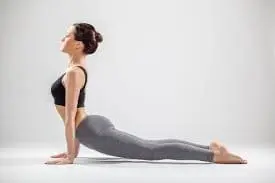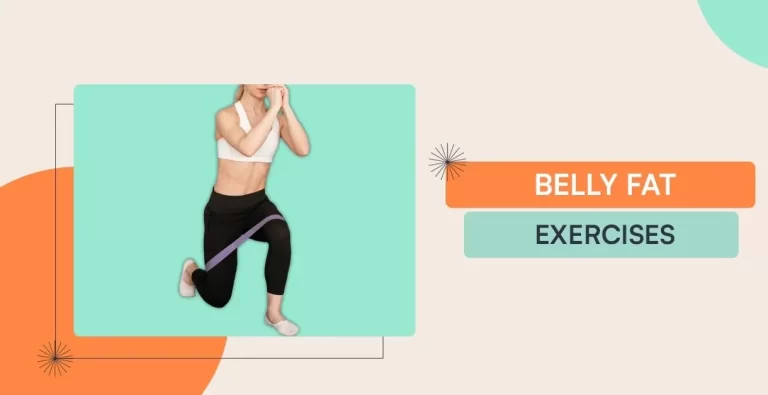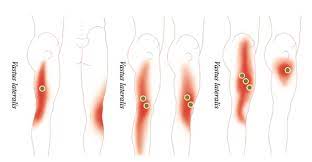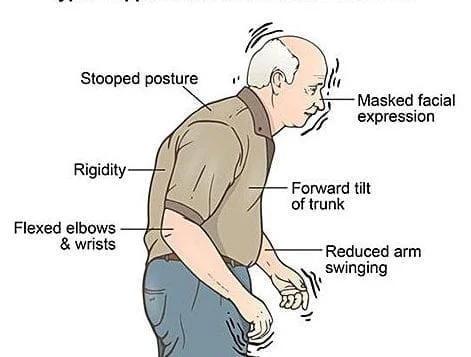11 Best Exercises for Herniated Disc
Herniated discs are a frequent spinal ailment that develops when the soft inner part of a spinal disc pushes through the outer layer, pressing on nearby nerves and producing pain and inflammation. Exercise is often recommended as part of conservative care for herniated discs to increase flexibility, strengthen the supporting muscles, and lessen pain.
Pain from a herniated disk might be lessened with the help of light exercises, stretches, and motions. Exercise can also help to maintain and increase the flexibility of the spine, neck, and back. Additionally, they might help stop a herniated disk from happening again. As mentioned earlier, exercise is a part of the recovery process for herniated discs. The type and intensity of exercise are essential for speeding up recovery and reducing the risk of further injuries.
What is a Herniated Disc?
When one of the discs is out of its normal position, it can cause a herniated disc, which is also referred to as a bulging or compressed disc. In particular, the annulus fibrosis, the outer part, is pressed upon by the nucleus pulposus, the inner component. This could cause harm to the spinal cord and nerve roots.
Though disc herniation is possible anywhere in the spine, it most frequently occurs in the neck (cervical spine) and lower back (lumbar spine).
Signs and symptoms:
While each person’s symptoms of a herniated disc are unique, the majority of them can be found below.
By applying pressure to the spinal cord or nearby nerve roots, the disc may result in symptoms (pinched nerve). A person may show minor, major, or severe symptoms, or they may show no symptoms at all.
Symptoms of the lumbar spine:
- A pain in the lower back, usually the initial sign
- Pain in the lower limbs that goes up and down
- Leg tingling or numbness
- Weakness in the lower limbs
- Sitting causes more harm than pain.
- Sciatica pain
Symptoms of the cervical spine:
- Hand numbness
- Arm pain
- Ache in the upper back
- Restricted mobility of the neck
How is exercising beneficial?
Long durations of sitting or lying down are bad for your health and don’t help your body heal from a herniated disc. It may worsen your disease or require more time to heal. Engaging in physical exercise can promote the healing of your neck and back while protecting and improving your general health.
Physical therapy and exercises are frequently crucial components of herniated disk healing. When a patient has a herniated disk, the doctor typically advises taking a few rest days.
The muscles that support the spine will become stronger with modest exercise, which will also relieve pressure on the spinal column. They may also help lower the chance of a repeat herniated disk by increasing spine flexibility.
A physician could advise reducing activity at first and increasing it gradually. They’ll go through which particular activities are OK to do during rehabilitation and which ones are not.
Practice flexibility and slowness in all of your activities, particularly while bending or lifting. Pain shouldn’t follow exercise. An individual needs to stop exercising and consult the doctor if they experience pain.
The advantages of exercises:
- Increased blood flow to the spine to help support and repair injury.
- Increased strength in the spine’s supporting muscles
- Reduced strain on the spine, which reduces pain
- Improving pain-related unusual postures
- Stretching the back muscles gently
- Increased spine flexibility
Exercises for Herniated Disc:
The ideal exercise for lumbar and cervical herniated discs is described here;
Stretches & Exercises for the Cervical Spine:
A Herniated Disc frequently results in neck pain. Pain in the neck and shoulder muscles might result from pressure on the nerves in the neck. Moreover, it could result in shooting pain.
Isometric neck exercise
- Take a seat comfortably to begin.
- Place your hand over your forehead.
- try to withstand the pull.
- Hold this pose for a few seconds.
- Then return to your neutral position.
- Then relax.
- Keeping your palm on the back of your head, gently press your neck in the direction of the force.
- Put slight pressure in the opposite direction of your movements while staying in the same position.
- Hold this pose for a few seconds.
- Then return to your neutral position.
- Then relax.
- Next, maintain a straight head while holding your left side of the head.
- Gradually press your left side of the head against your left shoulder.
- Hold this pose for a few seconds.
- Then return to your neutral position.
- Then relax.
- The right side of the neck should be bent with the same movement.
- Hold this pose for a few seconds.
- Then return to your neutral position.
- Then relax.
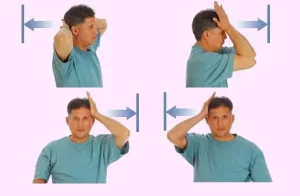
Chin tuck
- Sitting or standing upright, begin by focusing your eyes at a certain point in the room.
- Place your index finger on your chin to facilitate your motions.
- Shift your head slightly to the side and place your chin towards your neck.
- Due to the movement, your head shouldn’t sag to look at your toes; instead, it should create a double chin while you maintain your forward gaze.
- Hold this position for a few seconds.
- Then return to your neutral position.
- Then relax.
- Repeat this exercise four to eight times.
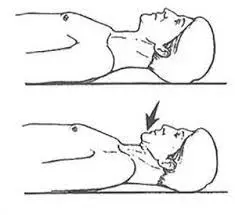
Shoulder Retraction Exercise
- The exercise requires you to sit or stand with your back to a wall to begin.
- Your arms ought to rest loosely at your sides.
- When your arms are at a ninety-degree angle at the elbow, flex your elbows.
- Rotate the shoulders back and down.
- Your shoulder blades should be pressed together as you press the backs of your upper arms against the wall.
- Hold this position for a few seconds.
- Then return to your neutral position.
- Then relax.
- Repeat this exercise four to eight times.
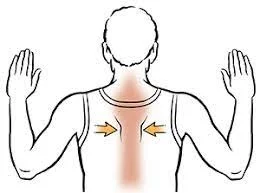
Side Bending Neck Stretch
- Start with a seating position on the chair.
- You can support your right arm by sitting on your hand or by gripping the front edge of the chair.
- Point your left ear toward your left shoulder while maintaining a straight line of sight.
- To progressively extend the stretch farther, you might utilize your left hand.
- Hold this position for a few seconds.
- Then return to your neutral position.
- Then relax.
- Repeat this exercise four to eight times.

Stretches & Exercises for the The Lumbar Spine:
By releasing tension from the muscles and relieving pressure on the spine, the exercises listed below can help relieve pain in the lower back.
Pelvic tilt
- Start with relaxing by lying down on the ground.
- Next, flex your knees together.
- Place both hands on your chest or your sides.
- The muscles in your abdomen should feel strong.
- Hold this position for a few seconds.
- Then return to your neutral position.
- Then relax.
- Repeat this exercise four to eight times.
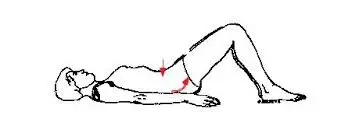
Bridges
- Start by settling into a comfortable position on the bed.
- After that, bend your knees while keeping your feet flat on the mattress.
- Then, contract your abdominal muscles.
- Lift your upper body.
- Keep your arms by your sides.
- Hold this position for a few seconds.
- Lower your body.
- Then return to your neutral position.
- Then relax.
- Repeat this exercise four to eight times.
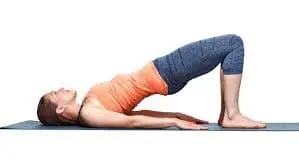
Cat cow
- Starting with your hands in the tabletop position, lay them on the ground.
- Make sure you have a straight back.
- Use both hands and feet to remain connected.
- Take a deep breath, hold your head up, and allow the air to fill your stomach.
- Hold this position for a few seconds.
- Then exhale, turn your back to face upward, and bring your chin up into your chest.
- There’s a slight extension of your lower back.
- Hold this position for a few seconds.
- Then return to your neutral position.
- Then relax.
- Repeat this exercise four to eight times.

Bird dog
- Start by lying down on your back and make sure your body is comfortable.
- Set your knees under your hips and your hands under your shoulders at this point.
- Hold your shoulder blades together tightly.
- Next, extend your left leg and right arm toward the ceiling.
- Keep a posture where your shoulders and hips are parallel.
- Hold this position for a few seconds.
- Then return to your neutral position.
- Then relax.
- Repeat this exercise four to eight times.
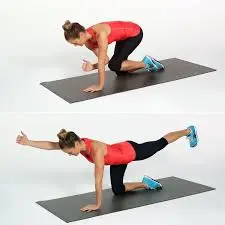
Knee to chest
- Start with a relaxing supine lying position on the ground.
- Bend your one knee.
- Your hand should be behind your knee or just below your kneecap.
- At this point, raise your knee to your chest.
- Hold this position for a few seconds.
- Then let your leg go down.
- Then return to your neutral position.
- Then relax.
- Repeat this exercise four to eight times.
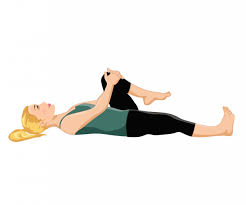
Piriformis stretch
- To begin, lay down on your back on the ground.
- Be careful to flex each knee.
- Maintain a level foot contact with the ground.
- You now have your left leg folded over your right ankle.
- Bring your leg up to meet your upper body.
- Hold this position for a few seconds.
- Then let your leg go down.
- Then return to your neutral position.
- Then relax.
- Repeat this exercise four to eight times.
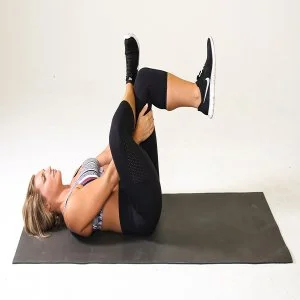
Back extensor exercise (cobra pose)
- Start with relaxing prone position on the ground.
- Place your palms flat on the ground near your shoulders.
- Holding your sides, your elbows should be straight back.
- look straight down at your mat with your neck in a neutral position.
- Take a deep breath to raise your chest off the ground.
- Keep your neck in a neutral position.
- Maintain a fixed gaze on the ground.
- Hold this position for a few seconds.
- Exhale to get back on the ground.
- Then return to your neutral position.
- Then relax.
- Repeat this exercise four to eight times.

Top 7 Exercises to Relieve a Disc Bulge – Lower Back
What precautions should I take when exercising?
- Every exercise should be done following the protocol, which requires stretches before and after each exercise as well as suitable repetitions.
- It is ideal to exercise in loose, relaxed outfits that encourage relaxation and free movement. Don’t dress in fashionable or tight outfits.
- Stretching the stiff muscles could be difficult, but it’s natural and even necessary. Stretching or exercise should never generate stabbing or painful sensations as this is harmful and contributes to the condition.
- Holding your breath while exercising is never recommended. after you start your exercise routine, take a deep breath, and after you’re done, exhale the breath slowly through your mouth. When exercising, holding your breath can lead to tense muscles and high blood pressure.
When did you stop taking part in this exercise?
- Fever
- Headache
- If your pain gets worse while exercising, just stop.
- Blurry vision
- If your physician suggests that you rest.
If you have a herniated disc, which exercise should you avoid?
If you have a herniated disk, you should refrain from doing repetitively demanding activities, heavy lifting, and sudden pressure on your back. All exercises that cause pain or make the patient feel as though they are aggravating the pain should be avoided by the patient.
Physical activity and high-impact sports may lead to or worsen a herniated disk. Heavy lifting, prolonged, intense exercise, or rapid pressure on the trunk can all cause a herniated disc. If you are recovering from a herniated disc, you should avoid doing anything physically demanding until your physician gives the all-clear.
- Activities with a high impact
- Activities that rely on flexibility
- Sit-ups
- Rotational movements
- Advanced core strengthening exercises
- Overhead weightlifting
- Bending forward repeatedly at the trunk
How Can Disc Herniation Be Prevented?
Even though it’s not always possible to completely prevent disc herniation, there are things you can do to reduce the risk and maintain the health of your spine.
The following guidance can help you in preventing disc herniation;
- Take a warm-up before working out
Before engaging in physical activities or exercising, warm up your muscles with gentle stretches and brief aerobic exercises. As you warm up your muscles and joints for exercise, you reduce your chance of injury.
- Engage in regular exercise
Regular exercise will develop your core muscles, which will help your spine. Your top priorities should be exercises that work the muscles in your back, pelvis, and abdomen. Stabilizing and maintaining the discs in your spine can be achieved by strengthening your core.
- Keep a healthy weight
Being overweight may put additional strain on your spine and increase your chance of developing a disc herniation. Your spine will experience less strain if you maintain a healthy weight through exercise and a balanced diet.
- Maintain proper body mechanics when carrying out daily duties.
Observe how your body performs when you raise it bend, and carry objects. To lessen the strain on your spine, keep focus on your posture and make any necessary adjustments.
- Stop smoking
By reducing blood flow and oxygen supply, smoking may harm spinal discs and make them less immune to damage. Quitting smoking can help your discs work better and lower your chance of disc herniation.
- Properly lift
Make sure you lift with the proper form to avoid back pain. To elevate using your legs rather than your back, bend your knees while maintaining a straight posture back. Stay away from twisting movements when lifting and moving large items.
Summary:
The pain and pressure associated with a slipped or herniated disk might be reduced by performing mild stretches and exercises. Before beginning an exercise program, make sure you consult your doctor to be sure you won’t injure your muscles or create new pain. Depending on where the herniated disk is located, a doctor can advise on the ideal exercise routines for each patient.
FAQ:
Can exercise help a herniated disc become more functional?
Stretching exercises are one of the greatest treatments for herniated disc symptoms. Back muscles can be gently stretched to increase flexibility and helps in stabilizing the disc herniation site. Exercises for herniated discs additionally improve general strength, movement, and discomfort.
What is the cause of herniated discs?
Numerous reasons, such as disc degeneration and aging, acute trauma or injury, lifting large objects incorrectly, frequent or excessive strain on the spine, and hereditary potential, can lead to disc herniation.
Is exercising safe for disc herniation people suffering?
While exercise can help with disc herniation, speaking with a physician or physical therapist before beginning any exercise regimen is important. They can advise you on safe workouts that help you manage your pain and build endurance, flexibility, and strength while avoiding clear activities that could make your condition worse.
Can a disc herniation recover by itself?
With conservative measures like rest, physical therapy, and medication, disc herniation symptoms can often get better or go away by themselves. However several factors, including the extent of the herniation, personal characteristics, and following specified treatment protocols, affect how quickly the wound heals.
Are there long-term effects associated with disc herniation?
Occasionally, ongoing symptoms or chronic pain might result from disc herniation. There may be a need for surgery if non-invasive therapies fail or the illness gets worse. Yet many people with disc herniation can have active, satisfying lives if they receive the right care and make lifestyle adjustments.
What’s the healing time of a herniated disc?
The length of recovery can vary based on several factors, including the individual, the effectiveness of treatment, and the degree of the herniation. While more severe cases or those requiring surgery may take longer to recover, mild to moderate disc herniations may improve within a few weeks to a few months.
References:
- Pietro Tirgar (2023, December 13). The Top 19 Exercises for Disc Herniation – Mobile Clinic for Physiotherapy. Mobile Clinic for Physiotherapy. Which workout is most beneficial for a herniated disc? https://mobilephysiotherapyclinic.in/19 for physical therapy
- On July 10, 2023, Patel, D. The Top 25 Exercises for Neck, Middle, and Lower Back Herniated Discs. Physiotherapy Clinic in Samarpan. What type of exercise is most beneficial for a disc herniation? For PT, visit https://mobilephysiotherapyclinic.in/19

